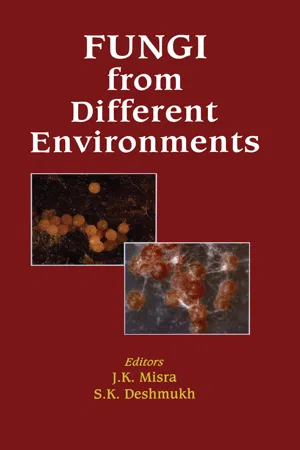Biological Sciences
Mycology
Mycology is the branch of biology that focuses on the study of fungi, including their genetic, biochemical, and ecological characteristics. It encompasses the identification, classification, and understanding of the roles fungi play in various ecosystems, as well as their interactions with other organisms. Mycologists study the diversity of fungi and their impact on human health, agriculture, and the environment.
Written by Perlego with AI-assistance
Related key terms
1 Key excerpts on "Mycology"
- eBook - ePub
- J K Misra(Author)
- 2019(Publication Date)
- CRC Press(Publisher)
2Fungi in the Air—AeroMycology: An OverviewS.T. TilakY.M. College, Erandwane, Bharati Vidyapeeth (Deemed University), Pune 411037, India Correspond to: 18, Vidya Sagar Society, Near Mahesh Society, Bibvewadi, Pune 411037, IndiaAbstract
India with its varied climatic conditions—temperate, tropical and coastal is distinct for aerobiological studies in general and aeromycological studies in particular. The credit goes to Cunningham who initiated studies of aerobiology in India (Cunningham, 1873). Currently, there are several centres where work on aerobiology and aeroMycology is underway. The work done at these centres has been referred to at appropriate places here.Environmental Mycology or aeroMycology constitutes one of the major aspects of aerobiology mainly because of the dominance of fungal spores in the ambient air. Aeromycological investigations take into account the identification of source, mode of release, dispersal, deposition, impaction and effects of impaction of fungal spores on various living systems. The fungal spores and hyphal fragments are commonly recorded in the air, and are important for the survival and subsequent continuation of generations. Many of the fungal spores have unique structures and the capacity to survive unfavourable environmental conditions.Fungal spores form an important constituent of bioaerosol and they are often well adapted to airborne dispersal. In the course of evolution, the fungi have probably exploited the wind for their dispersal more thoroughly than any other group of organisms and consequently dominate the airspora (80%-90%).The spores or fungal propagules are quite variable in size and shape. The spores or conidia range from 3-200 µm, most of these are about 10 µm in diameter. And they are often liberated in the air en masse and remain there for a long time.
Learn about this page
Index pages curate the most relevant extracts from our library of academic textbooks. They’ve been created using an in-house natural language model (NLM), each adding context and meaning to key research topics.
